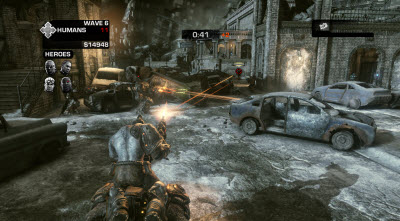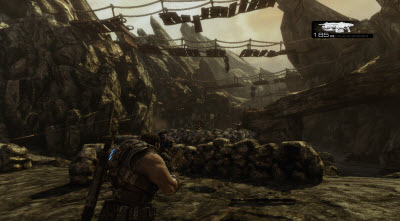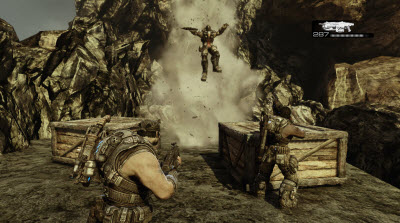Five acts for a Shakespearean tragedy
It’s kind of funny to think of Gears of War as Shakespearean, since the characters drop the F-bomb a lot and the game is billed as “bigger, better and more badass.” Th e game is split into five acts, so Epic Games is deliberately calling attention to the fact that the epic story is just as important as the game play itself. That distinction is welcome, since you get a sense that each major act has a big piece of the story to tell. By contrast, many games consist of 30 different chapters, each telling you a small piece of what is really a small story, not an epic story.
e game is split into five acts, so Epic Games is deliberately calling attention to the fact that the epic story is just as important as the game play itself. That distinction is welcome, since you get a sense that each major act has a big piece of the story to tell. By contrast, many games consist of 30 different chapters, each telling you a small piece of what is really a small story, not an epic story.
Gears of War 3 continues the story from the first two titles, which were visceral, bloody experiences portraying the troops of Delta Squad as they fought to save the last human inhabitants of the planet Sera from an unstoppable underground enemy dubbed the Locust Horde. Now, a new threat called the Lambent has infected the Locust Horde and created a new mutant enemy for humanity. The humans have to deal with Lambent, or glowing enemies that have mutated due to prolonged exposure to a chemical known as Imulsion.
This new game opens two years after the events of the last game, which saw the destruction of Jacinto, one of the last bastions of humanity. The civilization of the world has long since fallen apart, and survivors are just trying to get by in the ruins. You would think that by now, the humans would be back in the Stone Age. But there are still more human places to be protected or ruined, and there is still plenty of ammunition lying on the ground for the Gears to pick up and fire into receiving enemies. The human coalition has collapsed and the Locust have survived the previous human offensive in Gears of War 2 and they are now back and more fierce than ever. Fenix and his squad are stuck on an aircraft carrier, the Raven’s Nest, one of the last operational ships in the human arsenal. The Gears call the Lambent “the glowies,” and the art style makes them unmistakable when viewed in the environments of the game.
 As the game kicks off, A new commander arrives at the ship via helicopter and isn’t particularly welcome since he bailed out on the human forces in the past. The commander gives Fenix a disk to view. As Fenix plays the disk, he realizes that his father, who was supposed to be dead, is alive and has been working on a secret research project. Fenix is stricken, since he had been imprisoned because he disobeyed a direct order in a failed attempt to save his father. Now he learns his father is alive and has a mission for Fenix and his crew. After a decade of war, with billions dead, it’s time for a last stand.
As the game kicks off, A new commander arrives at the ship via helicopter and isn’t particularly welcome since he bailed out on the human forces in the past. The commander gives Fenix a disk to view. As Fenix plays the disk, he realizes that his father, who was supposed to be dead, is alive and has been working on a secret research project. Fenix is stricken, since he had been imprisoned because he disobeyed a direct order in a failed attempt to save his father. Now he learns his father is alive and has a mission for Fenix and his crew. After a decade of war, with billions dead, it’s time for a last stand.
“This is the end of the trilogy, and we wanted to bring closure to Marcus’s story, and part of that is his relationship with his father,” Fergusson said.
The return of Fenix’s father adds an emotional weight to the story. Cliff “Cliffyb” Bleszinski, the creative director at Epic and the visionary behind Gears of War, said at the Game Developers Conference in March that the Gears of War story came to him during a tough time. He was going through a divorce, and he was also thinking about the death of his own father, who passed away when Bleszinski was in his teens and just getting into video games. In creating Gears of War as a trilogy, Bleszinski and his team (this particular Gears story is penned by sci-fi writer Karen Traviss, the author of four Gears novels) had to dig deep into emotional territory and come up with something that would hold our attention for countless hours of game play.
It is no accident that the fictional character Fenix has “daddy issues,” Bleszinski said. In Gears of War 3, where gamers expect some closure to Fenix’s personal story, we expect to find out more. It is not unlike the story of Dom Santiago and his hopeless search for his girlfriend Maria in Gears of War 2. That personalized touch about a personal tragedy within the larger destruction of an entire world is what makes the Gears of War storyline more literary and epic. Gears of War 3 delivers on this story of personal loss in a most satisfying way that will leave the gamer feeling, “Now that’s a real ending.”
One of the enduring features of Gears of War is that its characters are memorable and they are treated as characters, not cannon fodder, as they often are in video games. Friendship is a big part of the game, and depths that characters go to in order to rescue friends in danger is one of its recurring themes. This ending to the story is welcome in part because so many of the other endings to video game trilogies leave so many openings for future sequels. Gears of War 3 delivers real closure.
 The action moves to bigger and better
The action moves to bigger and better
As I’ve said before, Gears of War creates one of the best combat experiences in video games. This game won’t let down anyone who has acquired a mastery of the controller button pushes and joystick moves that you have to pull off in order to survive combat with the multitude of enemies coming at you. When you are finished with a firefight, you’ll feel like you’re coming down from an adrenaline rush.
The style of Gears isn’t “run and gun,” as with most shooters. You have to pull the left trigger to aim in Gears and then shoot with the right trigger. Since it takes multiple shots to kill enemies, you have to focus on killing the enemies one at a time. If you’re out in the open, this gives other enemies time to surround you and take you down. So Gears is what is called a “cover-based” game, where you have to hide behind cover, peer around corners, and revive wounded comrades as you escape heavy fire.
The game environment always has lots of rectangular blocks that you can use as cover. These blocks are a kind of convention that makes you feel like you’re in a formulaic kind of battle. When a film-like sequence ends, such as when characters finish a conversation, the player takes control of Fenix and starts walking through the environment. When you see the blocks, you know that you’re about to get ambushed and it’s time to find some cover.
When you stick your head up to shoot, odds are good you’ll get shot at and be forced to duck or die. You get a wide variety of weapons, including the trusty lancer with its chainsaw bayonet. But each weapon is really geared at taking down one or maybe two or three enemies at once. That’s because Gears of War’s style is brutal one-on-one fighting, mostly at close range. Every kill feels like it’s happening inside a one-on-one gladiator arena. The great insight of the game designers is that outwitting a single opponent, when it comes to taking cover or making a surprising move, is really quite satisfying.
The game play in the third game has been honed, but it isn’t that different from the original. This is one of the weaknesses as well as strengths of the game. Fans will like it because it’s familiar, but skeptics will feel like there isn’t anything new here except the same kind of fighting with a new story. To deal with that complaint, Epic Games has made it possible for four players to play cooperatively at the same time.
